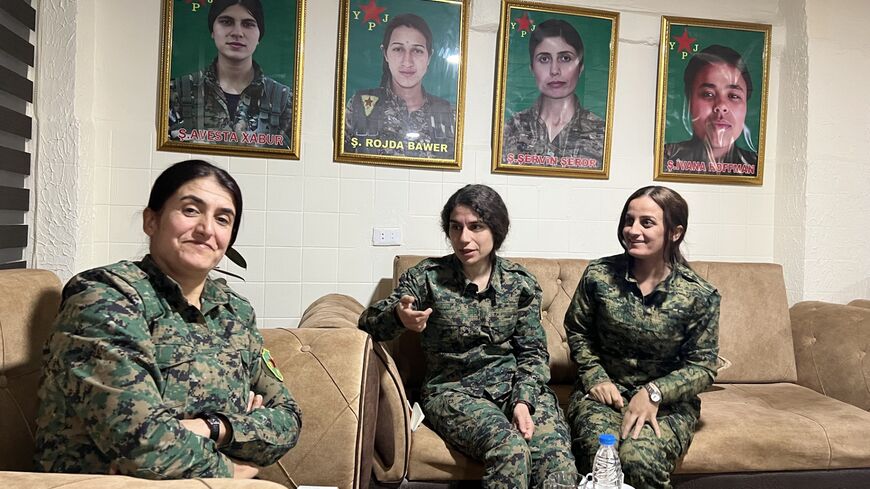As resurgent ISIS exploits Syria’s void, will Trump cede fight to Turkey?
Following the fall of the Syrian regime, the Islamic State is exploiting power vacuums to rebuild as Turkey positions itself to potentially take over counter-ISIS efforts while advancing its own regional interests.

“The single biggest concern I have is the resurgence of ISIS,” US national security adviser Jake Sullivan said over the weekend on CNN.
The lightning rebel advance led by Hayat Tahrir al-Sham that toppled the regime of longtime Syrian dictator Bashar al-Assad has left ungoverned spaces throughout the country. Over the past decade, the Islamic State has repeatedly proven adept at exploiting these power vacuums, using the opportunities to recruit, recuperate and rearm.
Since the fall of the Assad regime, the US military has conducted several bombing raids against ISIS positions in Syria. In the first wave in early December, B-52 bombers, F-15 fighters and A-10 Warthogs attacked 75 targets consisting of ISIS leaders, operatives and training camps. A week later US airstrikes killed another dozen ISIS fighters, targeting more operatives and training camps. Late last week, US Central Command announced that the United States had successfully eliminated ISIS leader Abu Yusif in Deir ez-Zor province in the latest round of precision strikes against the Islamic State’s leadership echelon.
The US offensive reflects a metastasizing threat in the heart of the Levant, where the Islamic State rose more than a decade ago. Since the fall of its territorial caliphate and the loss of its last piece of territory in Syria in March 2019, ISIS has done what successful insurgents have done for hundreds of years: win by not losing. This year alone, ISIS is on pace to triple its attacks compared to last year, increasing in lethality, complexity and geographic diversity.
Even as the group’s power ebbed and flowed in Syria over the past five years, it has retained a steady presence in the central Badia desert, occasionally showing signs of resurgence. In January 2022, ISIS fighters stormed a prison in al-Hasakah, sparking a 10-day battle in which hundreds of ISIS militants were killed but hundreds were also freed from captivity.
Prison camps most vulnerable
The most glaring vulnerability today is the prison camps and detention centers where hundreds of ISIS fighters are held. About 9,000 ISIS militants remain in these camps and upward of 40,000 of their family members, including women and children, are being held in deplorable conditions. The camps are guarded by the Syrian Democratic Forces, a Kurdish group that is Washington’s main ally in Syria, although Turkey accuses the group of being an offshoot of the Kurdistan Workers Party (PKK), a group designated by many countries as a foreign terrorist organization.
Camps like al-Hol and al-Roj are ticking time bombs where ISIS is likely conducting reconnaissance to determine when to launch an assault. And with growing tensions between the Kurds and Turkish-backed proxy forces including the Syrian National Army, there is a growing possibility that the SDF’s bandwidth may become overstretched, requiring Kurdish fighters to reinforce positions away from the camps. Moreover, the SDF has hemorrhaged Arab fighters, many of whom have flocked to join the HTS-led government, and its leadership is worried that it will not be able to count on support from Washington for the foreseeable future, a legitimate concern that the Kurds consider existential.
Not only would a successful ISIS prison break in these detention centers make for top-rate propaganda, but depending on which fighters were freed and how many, it could be a massive boon for the jihadist group, a desperately needed force multiplier at a time when the group has already seized upon its momentum and is looking to reassert itself in parts of Syria. During its peak, ISIS was taking in more than $1 million per day and likely has retained enough of its war chest to fund a low-level insurgency for years. A recent uptick in extortion and protection payments demonstrates that ISIS has retained its ability to gather critical intelligence, especially at local levels in towns and villages throughout Syria.
This month, the Pentagon said the United States has approximately 2,000 soldiers in eastern Syria, where for the better part of the last decade, the American military has sought to contain Iranian expansion while also combating the Islamic State. This number is more than double the 900 troops previously reported. The incoming Trump administration will face an early foreign policy test in Syria, where uncertainty surrounds the formation of a government capable of stabilizing the country. During his first term as president, Donald Trump was skeptical of US military involvement overseas but oversaw the successful campaign to destroy the Islamic State’s caliphate, dismantling its networks in Raqqa, Syria, and Mosul, Iraq.
Because of high-profile attacks in Iran and Russia and well-publicized foiled plots like the plan to attack a Taylor Swift concert in Vienna, Austria, much of the global media attention has focused on the Islamic State’s Afghanistan affiliate, Islamic State Khorasan, or ISIS-K. But ISIS in Syria has been slowly and patiently rebuilding without fanfare. The group boasts several thousand fighters and will likely use the current chaos to recruit new members, potentially including hard-line militants who were part of the broader HTS offensive but who disagree with leader Ahmed al-Sharaa’s emphasis on moderation, inclusion and pragmatism.
Will Trump hand fight over to Turkey?
The Trump administration may leave the bulk of the counter-ISIS fight in Syria to the Turkish military. It is not difficult to imagine Turkish President Recep Tayyip Erdogan convincing Trump that in exchange for withdrawing US troops from Syria, the Turkish military will keep ISIS at bay.
With no US military presence in Syria, Turkey would have free rein to fight against the Kurds. Turkey's foreign minister, Hakan Fidan, was the first diplomat to travel to Syria to meet with Sharaa, confirming what many already knew: Ankara wields the most influence with HTS and will be the major power player in Syrian politics, shaping what comes next.
Fidan said recently, “When you look at this from the perspective of US interests, when you do the math, is Turkey more important, or is a terrorist group like the PKK important? Mr. Trump sees the math right away.” He went on to say that the new HTS-run administration would be able to assume control of the ISIS prisons, a prospect sure to raise eyebrows in the West.
Heading into 2025, the fight against ISIS is facing a critical juncture. The United States will experience a change in leadership and while many observers are speculating, few know for certain which foreign policy positions the incoming administration will adopt. Wars continue to rage in Ukraine and the Middle East and there is a growing sense of counterterrorism fatigue, a hangover from the 20-plus-year Global War on Terrorism.
But in many ways, the disinterest and malaise of Western military, security and intelligence officials is exactly what groups like ISIS plan for, biding time and preparing — or to use the group’s own slogan, remaining and expanding — and waiting for the ideal moment to storm back onto the world stage.










